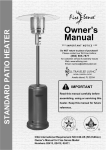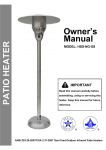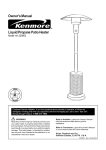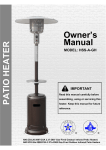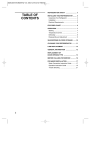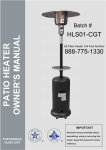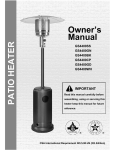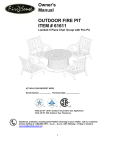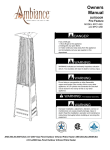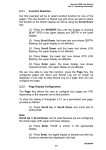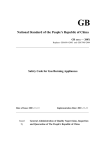Download Garden Radiance GS4150NGBK Instructions / Assembly
Transcript
PATIO HEATER Owner’s Manual GS4150NGBK GS4150NGSS IMPORTANT Read this manual carefully before assembling, using or servicing this heater. Keep this manual for future reference. R R ANSI Z83.26-2007/CSA 2.37-2007 Gas-Fired Outdoor Infrared Patio Heaters Contents DANGER General Safety Information....................................... 1 Assembly Instructions............................................. 3 DANGER indicates an imminently hazardous situation which, if not avoided, will result in death or serious injury. Components ........................................................... 3 WARNING Hardware ................................................................ 4 Additional Requirements ........................................ 4 WARNING indicates an imminently hazardous situation which, if not avoided, could result in death or serious injury. Installation Process Step1 - Attach Ground Fixer To Base ..................... 4 Step 2 – Attach Post to Base ................................. 4 Step 3 –Attach Post to Post..................................... 5 Step 4 – Attach Reflector Studs to Screen Cover... CAUTION CAUTION indicates an imminently hazardous situation which, if not avoided, may result in minor or moderate personal injury, or property damage. 5 DANGER Step 5 – Attach Head Assembly to Post.................. 5 Step 6 – Install Reflector......................................... 6 Step 7 – Attach Reflector Assembly to Studs.......... 7 Step 8 – Connect Hose & Regulator to Cylinder... 7 Leak Check............................................................. 8 Operation................................................................ 8 FOR YOUR SAFETY If you smell gas: 1. Shut off gas to the appliance. ([WLQJXLVKDQ\RSHQÀDPH 3. If odor continues, keep away from the appliance and immediately call your gas supplier or fire department. WARNING Operation Checklist ............................................... 10 Troubleshooting...................................................... 11 Maintenance........................................................... 11 Storage................................................................... 12 Do not store or use gasoline or other flammable vapors and liquids in the vicinity of this or any other appliance. Service.................................................................... 12 WARNING: General Safety Information For Outdoor Use Only This manual contains important information about the assembly, operation and maintenance of this patio heater. General safety information is presented in these first few pages and is also located throughout the manual. Keep this manual for future reference and to educate new users of this product. This manual should be read in DANGER CARBON MONOXIDE HAZARD This appliance can produce carbon monoxide which has no odor. Using it in an enclosed space can kill you. Never use this appliance in an enclosed space such as a camper, tent or home. conjunction with the labeling on the product. Safety precautions are essential when any mechanical or natural gas fueled equipment is involved. These precautions are necessary when using, storing, and servicing. Using this equipment with the respect and WARNING Improper installation, adjustment, alteration, service or maintenance can cause property damage, injury or death. Read the installation, operation and maintenance instructions thoroughly before installing or servicing this equipment. caution demanded will reduce the possibilities of personal injury or property damage. The following symbols shown below are used extensively throughout this manual. Always heed these precautions, as they are essential when using any mechanical or natural gas fueled equipment. DANGER Failure to comply with the precautions and instructions provided with this heater can result in death, serious bodily injury and property loss or damage from hazards of fire,explosion, burn, asphyxiation, and/or carbon monoxide poisoning. Only persons who can understand and follow the instructions should use or service this heater. 1 DANGER DANGER • EXPLOSION - FIRE HAZARD • Keep solid combustibles, such as building materials, paper or cardboard, a safe distance away from the heater as recommended by the instructions. • Provide adequate clearances around air openings into the combustion chamber. • Never use the heater in spaces which do or may contain volatile or airborne combustibles, or products such as gasoline, solvents, paint thinner, dust particles or unknown chemicals. • CARBON MONOXIDE HAZARD • This heater is a combustion appliance. All combustion appliances produce carbon monoxide (CO) during the combustion process. This product is designed to produce extremely minute, non-hazardous amounts of CO if used and maintained in accordance with all warnings and instructions. Do not block air flow into or out of the heater. • Carbon Monoxide (CO) poisoning produces flu-like symptoms, watery eyes, headaches, dizziness, fatigue and • During operation, this product can be a source of possibly death. You can't see it and you can't smell it. It's ignition. Keep heater area clear and free from combustible an invisible killer. If these symptoms are present during materials, gasoline, paint thinner, cleaning solvents and operation of this product get fresh air immediately! other flammable vapors and liquids. Do not use heater in • For outdoor use only . areas with high dust content. Minimum heater clearances • Never use inside house, or other unventilated or from combustible materials: three (3) feet from the sides & two (2) feet from the top. enclosed areas. • This heater consumes air (oxygen). Do not use in unventilated or enclosed areas to avoid endangering your life. CAUTION WARNING • SERVICE SAFETY We cannot foresee every use which may be made of our heaters. Check with your local fire safety authority if you have questions about heater use. Other standards govern the use of fuel gases and heat producing products for specific uses. Your local authorities • Keep all connections and fittings clean. • Inspect hose before use. Replace if there is evidence of abrasion or wear. • During set up, check all connections and fittings for leaks using soapy water. Never use a flame. • Use as a heating appliance only. Never alter in any way or can advise you about these. use with any device. If no local codes exist, follow National Fuel Gas Code, • Check entire hose at least annually. ANSI Z223.1. In Canada, installation must conform to local codes. If no local codes exist, follow the current National standards of CANADA CAN/CGA-B 149.2. WARNING • BURN HAZARD • Never leave heater unattended when hot or in use. • Keep out of reach of children. 2 WARNING Assembly Instructions Components Remove all components from package. GS4400-P1: REFLECTOR ASSY GS4150NG-P4: NUTS AND BOLTS GS4150NG-P5: HEATER BURNER SCREEN GS4150NG-P6: HEAD ASSEMBLY GS4150NG-P7-**: UPPER POST DANGER • EXPLOSION - FIRE HAZARD GS4150NG-P8: GAS HOSE GS4150NG-P9-**: MIDDLE POST • This heater is red hot during use and can ignite flammables too close to the burner. Keep flammables at least 3 feet from sides & 2 feet from top. Keep gasoline and other flammable liquids and vapors well away from heater. GS4150NG-P10-**: LOWER POST GS4150NG-P11-**: BULLET COVER GS4150NG-P12-**: BASE GS4150NG-P7, GS4150NG-P9, GS4150NG-P10, GS4150NG-P11, & GS450NG-P12 REQUIRE COLORS -BK (BLACK), -SS (STAINLESS) 3 WARNING California Proposition 65 Combustion by products produced when using this product contain chemicals known to the state of California to cause cancer, birth defects, and other reproductive harm. Used in Hardware (GS4150NG-P4) Picture Step(s) Qty Description 3 Ground Fixer 1 6 Small Bolt 1 6 Small Flat Washer 1 6 Nut 1 4 Medium Bolt 2 4 Large Flange Nut 4 Small Screw 3 9 Small Screw 6 Small Flat 9 Washer Reverse the base, fix the ground fixer to the base with bolts and washers like picture shows. 3 Req’d Ground Fixers Firm the ground fixer with nuts. 6 Req’d Small Flats 2 Washer To protect heater from strong wind, anchor the base securely to the ground with screws. 6 Req’d Small Bolts Small Screw Large Flat Step 1 – Attach Ground Fixer To Base 2 4 9 Installation process 6 Req’d Washer Nuts Fix another two ground fixer with bolts and nuts, and reverse the base. 4&7 6 9 Cap Nut 6 3 Wing Nut 7 3 Reflector Stud 4 1 Wrench 1/5/6 Step 2 – Attach Post to Base Put lower post through the hole on the top of base, attach lowerpost to base using four large bolts. Additional Requirements The following items are not included, but are necessary for .. . 4 Req’d Medium Bolts the proper assembly of your heater. Do NOT attempt to assemble without proper tools. Philips screwdriver w/ medium blade. Adjustable opening wrench. Leak Detection Solution(Instructions on how to make solution are included in leak check process. Note: You must follow all steps to properly assemble heater. 4 4 Req’d Large Flange Nuts Fully tighten all of the screws. .. Step 4 – Attach Reflector Studs to Screen Cover Insert 3 Reflector Studs & 3 Flat Washers. Tighten studs securely. 3 Req’d Reflector Studs 3 Req’d Large Flat Washers Attach bullet cover loosely to base with 4 pcs M5x8 screw. 4 Req’d Small Screw Step 3 – Attach Post to Post Attach lower post and upper post to the each end of middle post.Using 4 screws to fasten them. 4 Req’d Small Screw . Step 5 – Attach Head Assembly to Post Screw off 4 small bolts. 4 Req’d Small Bolts Head Assembly Hose is not included in the product. Need Purchase Separately. 5 Load Head Assembly by inserting hose into post. Insert Head Assembly into post. 9 Req’d Small Screw s Control knob should be above decal on post. . 9 Req’d Small Flat Washers 9 Req’d Cap Nuts Slide one Small Flat Washer over threaded end of screw and screw on Cap Nut loosely. Attach Head Assembly to post, and loosely install four small bolts. Tighten bolts securely. . . Step 6 – Install Reflector WARNING Remove protective cover before assemble. Slide Reflector Plate onto Reflector Panels. Insert Screw. one Small . Slide one Small Flat Washer over threaded end of screw on screw and Cap Nut loosely. Note: If necessary for proper alignment of reflector . . sections, loose each screw prior to further assembly and retighten after sections are aligned. 6 Slide two Reflector Panels together. Insert Screw. one Small . . Repeat procedure to complete the assembly of all four sections. Fully tighten all of the screws in the rolled edge. .. Step 7 – Attach Reflector Assembly to Studs Support Heater. Slide 3 Large Flat Washers over threaded end of Studs. 6 Req’d Large Flat Washers . Step 8 – Connect Hose You must provide natural gas . Use this heater only with a natural gas vapor withdrawal supply system. 3 Req’d Wing Nuts A minimum supply pressure of 0.12 p.s.i. is required for the purpose of input adjustment for natural gas.ANSI Z223.1/NFPA54, Natural Gas and Propane Installation Code, CSA B149.1, or Propane Storage and Handling Code, B149.2. The installation must conform with local codes, or in the absence of local codes,with National Fuel Gas Code, ANSI Z223.1/NFPA54, Natural Gas and Propane Installation Code, CSA B149.1, or Propane Storage and Handling Code, B149.2. A dented, rusted or damaged propane cylinder may be hazardous and should be checked by your cylinder supplier. Never use a propane cylinder with a damaged valve connection. .. Locate Reflector Assembly on 3 studs. Install large flat washers on studs & securely tighten Screw regulator onto gas hose. Do not cross-thread. wing nuts but do not over-tighten! Tighten securely. Attach regulator to hose. Complete attachment. 7 Leak Check Operation WARNING DANGER • Perform all leak tests outdoors. • Extinguish all open flames. • CARBON MONOXIDE HAZARD • NEVER leak test when smoking. • Do not use the heater until all connections have been leak • For outdoor use only. Never use inside house, or other tested and do not leak. unventilated or enclosed areas. This heater consumes air (oxygen). Do not use in unventilated or enclosed areas to avoid endangering your life. The appliance must be isolated from the gas supply piping system by closing its individual manual shoutoff valve during any pressure testing of the gas supply piping system at test pressures equal to or less than 1/2 psig (3.5kPa). Hose / Regulator Connection Make 2-3 oz. of leak check solution (one part liquid dishwashing detergent and three parts water). Apply several drops of solution where hose attaches to regulator. Apply several drops of solution where regulator connects to Natural gas Valve. Make sure all Patio Heater & Light valves are OFF. Turn Natural gas Valve ON. If bubbles appear at any connection, there is a leak. Turn Natural gas Valve OFF. If leak is at Hose/Regulator connection: tighten connection and perform another leak test. If bubbles continue appearing should be returned to Hose’s place of purchase. If leak is at Regulator/Natural gas Valve connection: disconnect, reconnect, and perform another leak check. If you continue to see bubbles after several attempts, Natural gas Valve is defective and should be returned to cylinder’s place of purchase. . . If NO bubbles appear at any connection, Caution: Do not attempt to operate until you have read the connections are secure. Turn Natural gas Valve OFF. NOTE: Whenever gas connections are loosened or removed, you must perform a complete leak test. 8 Complete installation. & understand all General Safety Information in this manual and all assembly is complete & leak checks have been performed. . . .. .. 3) Before Turning Gas Supply ON: Your heater was designed and approved for outdoor use only. Do NOT use it inside a building, garage, or any other enclosed area. 4) Make sure surrounding areas are free of combustible materials, gasoline, and other flammable vapors or liquids. 5) 6) Ensure that there is no obstruction to air ventilation. Be sure all gas connections are tight and there are no leaks. Be sure the cylinder cover is clear of debris. Push in gas Control Knob and turn counterclockwise to “IGNITER” then to “PILOT” (Figure b) to light the pilot. If needed, keep depressing and turning Control Knob counterclockwise until the pilot lights (You should heater 2 clicking sounds). Once the pilot is lit, continue to depress the control Knob for 30 seconds. If the pilot dose not stay lit, repeat steps 3 and 4. If after repeating steps 3 & 4 unit does not light, then -Push in Control Knob and turn counterclockwise to “PILOT”. -As you are depressing the Control Knob, place long stem lighter into the ignition hole (Figure c) on the Emitter Screen to light the pilot. -Repeat step 4. Be sure any component removed during assembly or servicing is replaced and fastened prior to starting. Before Lighting Heater should be thoroughly inspected before each use, and by a qualified service person at least Figure c Push in and turn the Control Knob to the “LOW” position, then release Control Knob. If you want a higher temperature, push in the Control Knob and turn counterclockwise to the “HIGH” position. annually. 7) If relighting a hot heater, always wait at least 5 minutes. Inspect the hose assembly for evidence of excessive abrasion, cuts, or wear. Suspected areas should be After First Lighting leak tested. If the hose leaks, it must be replaced prior to operation.Only use the replacement hose assembly specified by manufacturer. Hose assembly supplier with the appliance must be used, and a statement that replacement and hose assemblies must be those specified by the appliance manufacturer. Lighting: -The burner may be noisy when initially turned on, To eliminate excessive noise form the burner, set the Control Knob to “LOW”, then turn the Control Knob to heat level desired. -White smoke may appear around the Emitter Screen during the first few minutes of initial lighting. This is the heater burning up the oil used in manufacturing. Both smoke and odor will dissipate after approximately 30 minutes. Note: This heater is equipped with a Pilot Light that allows for safer startups and shutdowns. Pilot must be lit before Main Burner can be started. 1) Turn the Control Knob to the “OFF” position (Figure a). Note: For initial start or after any cylinder change, hold Control Knob IN for 2 minutes to purge air from gas lines before proceeding. OFF OFF P P H W IG LO H H IG H PIL OT PIL OT Figure a o tu rn o tu rn W ht ht us us LO NOTE: The flame pattern at the Emitter Screen should be visually checked whenever heater is operated. Normally the burner flame is blue, but lighter yellow flame is acceptable. If flames extend beyond surface of the Emitter Screen or a black spot is accumulating on the Emitter Screen or reflector, shut off the heater. See Troubleshooting on page 11. Do not operate until heater has been serviced or repaired.If pilot fails to remain lit, all valves should be closed and waiiting period of at least 5 minutes should pass before attempting to light. Figure b Normal Abnormal 9 If you experience any ignition problem please consult “Troubleshooting” on page 11. Caution: Avoid inhaling fumes emitted from the heater’s first use. Smoke and odor from the burning of oils used in manufacturing will appear. Both smoke and odor will dissipate after approximately 30 minutes. The heater should NOT produce thick black smoke. Note: The burner may be noisy when initially turned on. To . . . Shut Down: Turn Control Knob clockwise to Pilot. (Normally, burner will make a slight popping sound when extinguished.) Burner will extinguish but Pilot will remain ON. To extinguish Pilot, depress Control Knob and continue to turn it clockwise to OFF. Turn natural gas Valve clockwise to OFF and disconnect Regulator when heater is not in use. eliminate excessive noise from the burner, turn the Control Note: After use, some discoloration of the emitter screen is Knob to the Pilot position. Then, turn the knob to the level normal. Operation Checklist of heat desired. For a safe and pleasurable heating experience, perform this check before each use. WARNING FOR YOUR SAFETY Be careful when attempting to manually ignite this heater. Holding in the control know for more than 10 seconds before igniting the gas will cause a ball of flame upon ignition. When heater is ON: Emitter screen will become bright red due to intense heat. The color is more visible at night. Burner will display tongues of blue and yellow flame. These flames should not be yellow or produce thick black smoke, indicating an obstruction of airflow through the burners. The flame should be blue with straight yellow tops. If excessive yellow flame is detected, turn off heater and consult “Troubleshooting” on page 11. Re-lighting: Note: For your safety, Control Knob cannot be turned OFF .. . without first depressing Control Knob in PILOT position and then rotating it to OFF. Turn Control Knob to OFF. Wait at least 5 minutes, to let gas dissipate, before attempting to relight Pilot. Repeat the “Lighting” steps on prior page. WARNING FOR YOUR SAFETY Heater will be hot after use. Handle with extreme care. 10 Before Operating: I am familiar with entire owner’s manual and understand all precautions noted. All components are properly assembled, intact and operable. No alterations have been made. All gas connections are secure and do not leak. Wind velocity is below 10 mph. Unit will operate at reduced efficiency below 40°F. Heater is outdoors (outside any enclosure). There is adequate fresh air ventilation. Heater is away from gasoline or other flammable liquids or vapors. Heater is away from windows, air intake openings, sprinklers and other water sources. Heater is at least 36" on top and at least 24" on sides from combustible materials. Heater is on a hard and level surface. There are no signs of spider or insect nests. All burner passages are clear. All air circulation passages are clear. Children and adults should be alerted to the hazards of high surface temperatures and should stay away to avoid burns or clothing ignition. Young children should be carefully supervised when they are in the area of the heater. Clothing or other protective material should be not hung from the heater, or placed on or near the heater. Any guard or other protective device removed for servicing the heater must be replaced prior to operating the heater Installation and repair should be done by a qualified service person. The heater should be inspected before use and ate least annually by a qualified service person. More frequent cleaning may be required as necessary. It is imperative that control compartment, burner and circulating air passageways of the heater be kept clean. After Operation Gas control is in OFF position. Gas Hose valve is OFF. Disconnect Gas line. Troubleshooting If the problem is: And this condition exists: Then do this Blockage in orifice or pilot tube Clean or replace orifice or pilot tube Open gas line and bleed it (pressing control Pilot won’t light Air in gas line knob in) for not more than 1 - 2 minutes or until you smell gas Use match to light pilot; obtain new igniter Igniter fails Note: Heater operates and replace at reduced efficiency below 40ºF (5ºC) Dirt built up around pilot Clean dirt from around pilot Connection between gas valve and Pilot won’t stay lit Tighten connection and perform leak check pilot assembly is loose Thermocouple is not operating correctly Replace thermocouple Blockage in orifice Clear blockage Control knob is not in ON position Turn control knob to ON Supply hose is bent or kinked Straighten hose Control knob fully ON Check burner and orifices for blockage Carbon build-up Dirt or film on reflector and burner screen Clean reflector and burner screen Thick black smoke Blockage in burner Burner won’t light Burner flame is low Remove blockage and clean burner inside and outside Keep exterior surfaces clean. Maintenance Use warm soapy water for cleaning. Never use flammable or corrosive cleaning agents. WARNING FOR YOUR SAFETY: • Do NOT touch or move heater for at least 45 minutes after use. While cleaning your unit, be sure to keep the area around the burner and pilot assembly dry at all times. Do not submerge the control valve assembly. If the gas control is submerged in water, do NOT use it. It must be replaced. a. Keeping the appliance area clear and free from combustible • Reflector is hot to the touch. materials , gasoline and other flammable vapors and liquids. b. Not obstructing the flow of combustion and ventilation air. • Allow reflector to cool before touching. c.Keeping the ventilation opening(s) of the cylinder enclosure free and clear from debris. To enjoy years of outstanding performance from your Air flow must be unobstructed. Keep controls, burner, heater, make sure you perform the following maintenance and circulating air passageways clean. Signs of possible activities on a regular basis: blockage include: 11 .. .. . . Gas odor with extreme yellow tipping of flame. Heater does NOT reach the desired temperature. Heater glow is excessively uneven. Heater makes popping noises. . . Store heater upright in an area sheltered from direct contact with inclement weather (such as rain, sleet, hail, snow, dust and debris). If desired, cover heater to protect exterior surfaces and to help prevent build up in air passages. Note: Wait until heater is cool before covering. Spiders and insects can nest in burner or orifices. This dangerous condition can damage heater and Service render it unsafe for use. Clean burner holes by using a heavy-duty pipe cleaner. Compressed air may help Repair to gas passages and associated components clear away smaller particles. should be done only by a qualified service person. Carbon deposits may create a fire hazard. Clean dome and burner screen with warm soapy water if Caution: any carbon deposits develop. attempting service. Note: In a salt-air environment (such as near an ocean), corrosion occurs more quickly than normal. Frequently check for corroded areas and repair them promptly. TIP: Use high-quality automobile wax to help maintain the appearance of your heater. Apply to exterior surfaces from the pole down. Do not apply to emitter screen or domes. Storage .. . Between uses: Turn Control Knob OFF. Store heater upright in an area sheltered from direct contact with inclement weather (such as rain, sleet, hail, snow, dust and debris). If desired, cover heater to protect exterior surfaces and to help prevent build up in air passages. Note: Wait until heater is cool before covering. .. During periods of extended inactivity or when transporting: 12 Turn Control Knob OFF. Disconnect natural gas source and move to a secure, well-ventilated location outdoors. Always allow heater to cool before














